1. Ration and its Comparison
- Books Name
- CBSE Class 6 Mathematics Book
- Publication
- Param Publication
- Course
- CBSE Class 6
- Subject
- Mathmatics
Ratio
A ratio is a comparison of two numbers (quantities) by division. A ratio is usually denoted by the symbol (:). The ratio of a to b (b ≠ 0) is written as a : b or ![]()
In the ratio a : b, a and b are called terms of the ratio. 'a' is the antecedent and 'b' is the consequent.
A ratio is a number, so to find the ratio of two quantities they must be expressed in the same units.
Properties of Ratios
(a) In a ratio, two quantities are compared. So, the quantities must be of the same kind. i.e., they must be expressed in the same units.
(b) The value of a ratio remains unaltered if the given ratio is multiplied or divided by the same non-zero quantity.
(c) The order of the terms in a ratio a : b is very important. The ratio 3 : 2 is different from the ratio 2 : 3.
Ratio in the simplest or lowest form :

Ex.1 Find the ratio of the following :
(a) 36 minutes to 2 hours.
(b) 32 g to 1 kg
(c) 3 days to 1 years.
Sol. (a) Change both 36 minutes and 2 hours to the same unit.
Now, 36 minutes = 36 minutes
2 hours = 2 × 60 minutes = 120 minutes
∴ Ratio of 36 minutes to 2 hours

(b) First convert both into numbers with the same unit.
32 g = 32 g
3kg = 3000 g

(c) First , convert both into numbers with the same unit.
3 days = 3 days
1 year = 365 days
Ratio = 3 : 365
Ex.2 Find the (i) ratio of M20 to M80 (ii) ratio of 3 km to 600m
Sol. (i) 20 : 80 or 1 : 4
(ii) 3000m : 600m or 3000 : 600 or 5 : 1
Comparison of Ratios :
1. Write the given ratios as fractions in the simplest form.
2. Find the LCM of the denominators of the fractions.
3. Convert them into like fractions with same denominators .
4. Compare the numerators and arrange the fractions.
5. Then respective ratios are also in the same order.
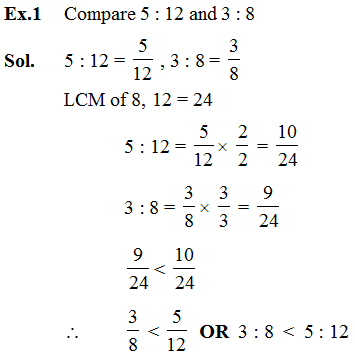
Ex.2 Two numbers are in the ratio 4 : 5. If the sum of the number is 63, then find the numbers.
Sol. Here 63 is to be divided in the ratio 4 : 5.

Ex.3 Mr. Harry divided Rs. 84,630 between Shinchan and Nimavari in the ratio 3 : 4. How much did each of them get ?
Sol. Ratio of money between Shinchan and Nimavari = 3 : 4
Sum of the terms of the ratio = 3 + 4 = 7
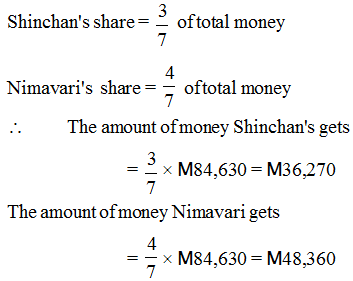
1. Ration and its Comparison
- Books Name
- Class 6 Mathematics Book
- Publication
- ReginaTagebücher
- Course
- CBSE Class 6
- Subject
- Mathmatics
Chapter 12
Ratio and Proportion
Ratio and its Comparison
Recalling about fractions
It is common to compare two amounts that are of same type. We compare prices of two belongings, height to of two people, size of different belongings, age of people etc.
For e.g. Let the price of a booklet is Rs. 10 and the price of a diary is Rs. 30.
Hence,
We get that the price of a diary is Rs. 20(Rs30 – Rs10) added than the price of a booklet. However, if we wish to compare the prices of these two belongings again taking the difference is not enough to express the comparison.
Therefore, we use ratio. In many situations, calculating the proportion is considered as an added meaningful way of comparing quantities. It is obtained by using division, i.e. by seeing how many times one quantity is to the other quantity. This method is known as comparison by ratio.
For example, the price of a booklet is Rs. 10 and price of a diary is Rs. 30.
We say that price of a diary and price of a booklet are in the rate 3: 1. This is obtained by
Price of a Diary/ Price of a booklet = 30/10 = 3/1
We can say that the cost of the diary is three times the cost of the booklet.

Ratio,
In certain situations, comparison by division makes better sense than comparison by taking the difference. The comparison by division is known as the Ratio. Originally, it is important to remember that for comparison, the two amounts must be in the same unit. However, they should be expressed in the same unit before the ratio is taken, if they are not in the same unit. Secondly, the ratio in which amounts are taken is also important. E.g. when the price of diary is Rs. 30 and the price of booklet is Rs. 10, we get the following
Price of a Diary/ Price of a Notebook = 30/10 = 3/1
Price of a Tablet/ Price of a Diary = 10/30 = 1/3
Therefore, the order in which amounts are taken to express their ratio is important.
Another important property of ratio is we can get original ratios by multiplying or dividing the numerator and denominator by the same number.
6 4 = 6/4 = 6 *2/4 * 2 = 12/8
Properties of ratio
Two quantities can be compared only if they are in same units. Equivalent ratios can be determined by multiplying or dividing the numerator and denominator by the same number.
Ratio in simplest form
The simplest form of the ratio is when the numbers are expressed as natural numbers with no common factors between them. For example, 2: 4 can be written in the simplest form as 1: 2.
1. A ratio between two quantities of same kind and in the same units is obtained on dividing one quantity by the other and has no unit. The ratio is independent of the units used in the quantities compared.
2. The ratio must always be expressed in its simplest form or in its lowest terms.
A ratio is said to be is the simplest form or in the lowest term if two quantities of a ratio (i.e., antecedent and consequent) have no common factor (i.e. antecedent and consequent are co-prime) other than 1 (or their HCF is 1.)
Equivalent ratios,
Equivalent ratios are the ratios that are the same when we compare them. Two or more ratios can be compared with each other to check whether they are equivalent or not. For example, 1:2 and 2:4 are equivalent ratios.
Comparison of ratios
Comparison of ratios means comparing the relationship between two or more ratios. The quantitative relationship of two amounts or numbers is called ratio and when 3 or more quantities come into play, a comparison of ratios is necessary.
Check the ratios are equivalent or not
By multiplying each ratio by the second number of the other ratio, you can determine if they are equivalent.
Multiply both numbers in the first ratio by the second number of the second ratio. For example, if the ratios are 3:5 and 9:15, multiply 3 by 15 and 5 by 15 to get 45:75.
Multiply both numbers in the second ratio by the original second number of the first ratio. In this example, multiply 9 by 5 and 15 by 5 to get 45:75.
Compare the results. If the results are equal, the two ratios are equivalent. If not, they are not equivalent and the ratio with the higher first number is larger. For example, if you had started with the ratios 3:5 and 12:15, you would get 45:75 and 60:75. Since the second ratio has the higher first number, (60 is greater than 45), 12:15 is larger than 3:5.
2. Proportion and Unitary Method
- Books Name
- CBSE Class 6 Mathematics Book
- Publication
- Param Publication
- Course
- CBSE Class 6
- Subject
- Mathmatics
Equivalent Ratios
Therefore, we can get equivalent ratios by multiplying or dividing the numerator and denominator by the same number.
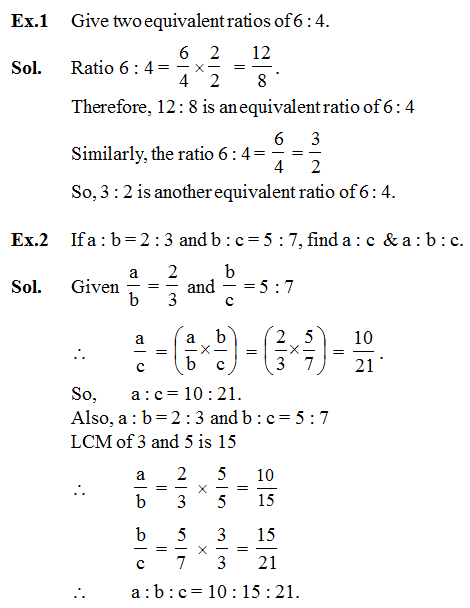
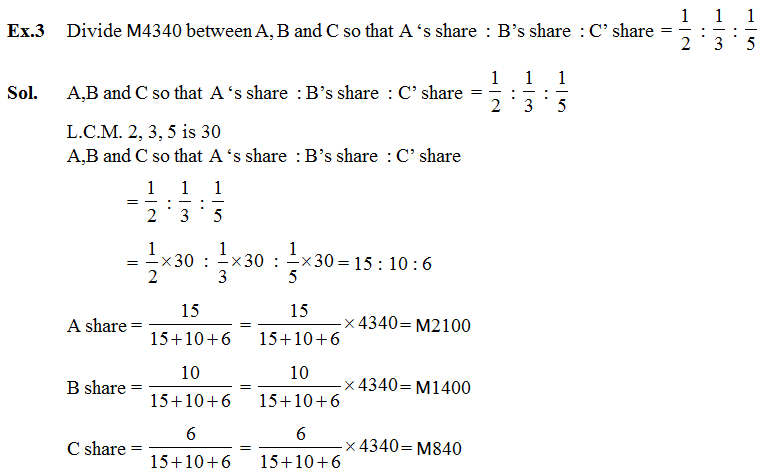
2. Proportion and Unitary Method
- Books Name
- Class 6 Mathematics Book
- Publication
- ReginaTagebücher
- Course
- CBSE Class 6
- Subject
- Mathmatics
Proportion and Unitary Method
Concept of proportion,
However, we say that they're in proportion and use the If two ratios are equal.
Symbol ‘’ or ‘=’ to equate the two ratios. Four quantities are said to be in proportion, if the ratio of the first and the second quantities is equal to the ratio of the third and the fourth quantities.|
e.g., we can say 2, 10, 5, and 25 are in proportion that is written as 2 10 5 25 and is read as 2 is to 10 as 5 is to 25 or it has written as 2 10 = 5 25.
However, then we say that they are not in proportion, If two ratios are not equal.
In a statement of proportion, the four quantities involved when taken in order are known as respective terms. First and fourth terms are known as extreme terms. Second and third terms are known as middle terms. In the above example, 2 and 25 are extreme terms while 10 and 5 are middle terms.
Proportionality law
When two ratios are in proportion a: b:: c:d, then the product of the extremes is equal to the product of the means. This is called the proportionality law.
Here 'a' and ’d’ are the extreme values and 'b' and 'c' are the mean values.
In addition, if two ratios are equal, then they can be related as follows.
ab=cdad=bc
It is called the cross product of proportion.
It says that 'when two ratios are in proportion a:b::c:d, then the product of the extremes is equal to the product of the means'
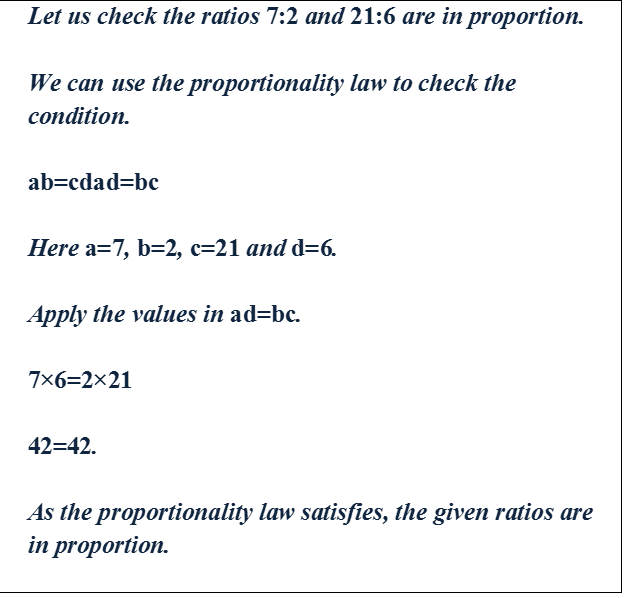
Unitary method,
The method in which we first find the value of one unit and then the value of the required number of units is called as the unitary method.
If the value of 4 pencils is Rs40, what is the value of one pencil?

Value of 4 pencils = Rs. 40
Value of 1 pencil = 40/4
= Rs.10
The value of one pencil is Rs.10. Now it is possible to calculate the price of any required number of units.
If we want to calculate the value of 100 pencils then:
Value of 1 pencil = Rs.10
Value of 100 pencils = 10*10 = Rs.100
Following examples further explain this method.
Problem: If it has rained 276 mm in the last 3 days, how many cm of rain will fall in one full week (7 days)? Assume that the rain continues to fall at the same rate.

Solution:
Amount of rain in the last 3 days = 276mm
Amount of rain in 1 day = 276/3
Amount of rain in 1 day = 92 mm
Amount of rain in a week = Amount of rain in 7 days
Amount of rain in 7 days = 7*(Amount of rain in 1 day)
= 7*92
Amount of rain in 7 days = 644 mm.
Problem: A truck requires 108 litres of diesel for covering a distance of 594 km. How much diesel will be required by the truck to cover a distance of 1650 km?

Litres of diesel used in covering 594 km = 108 litres
Litres of diesel used in covering 1km = 108/594
= 0.1818 litres
Litres of diesel required in covering 1650 kms
= 1650*(litres of diesel used to cover 1 km)
Litres of diesel required in covering 1650 kms = 1650*0.1818
= 299.97 litres.
= 300 litres (Apporx.)
Application of ratios
Problem: Cost of a toffee is 50 paise and cost of a chocolate is Rs 10. Find the ratio of the cost of a toffee to the cost of a chocolate.

Solution: As mentioned above, it is important that both the quantities be in the same unit for comparison.
Cost of a toffee = 50 paise
Cost of a chocolate = Rs. 10
= 1000 paise (Rs. 1 = 100 paise)
Cost of a toffee/ Cost of a chocolate = 50/1000 = 1/20
Thus, the ratio is 1:20
Problem: Out of 30 students in a class, 6 like football, 12 like cricket and remaining like tennis. Find the ratio of Number of students liking football to number of students liking tennis.

Solution: Number of students that like football = 6
Number of students that tennis = Total students – No. of students that like cricket – No. of students that like football
Number of students that like tennis = 30-12-6 = 12
Number of students that like football/ Number of students that like tennis
= 6/12 = 1/2
Thus, the required ratio is 1:2.
Problem: Cost of a dozen pens is Rs 180 and cost of 8 ball pens is Rs 56. Find the ratio of the cost of a pen to the cost of a ball pen.

Solution:
Cost of a dozen pens = Rs.180
Number of pens in a dozen = 12
Cost of 12 pens = Rs180
Cost of 1 pen = 180/12 = Rs.15
Cost of 8 ball pens = Rs.56
Cost of 1 ball pen = Rs.56/8 = Rs. 7
The ratio of the cost of a pen to the cost of a ball pen is:
Cost of a pen/ Cost of a ball pen = 15/7
Therefore, the required ratio is 15:7.
Problem: Mother wants to divide Rs 36 between her daughters Shreya and Bhoomika in the ratio of their ages. If age of Shreya is 15 years and age of Bhoomika is 12 years, find how much Shreya and Bhoomika will get.

Solution:
Age of Shreya = 15 years
Age of Bhoomika = 12 years
Therefore, the two parts of the ratio are 15 and 12.
Since, we can get equivalent ratios by multiplying or dividing the numerator and denominator by the same number. 3 can divide 15 and 11 and we can get the two parts of the ratio as 5 and 4.
Therefore, sum of these parts = 5 + 4 = 9
This means if there is Rs 9, Shreya will get Rs 5 and Bhoomika will get Rs.4.
Alternatively, we can say that Kriti gets 5 parts and Bhoomika gets 4 parts out of every 9 parts.
Therefore, Shreya’s share = 5/9
And Bhoomika’s share = 4/9
Out of given Rs.36:
Shreya’s Share = 5* 36/9 = 5*4 = 20.
Bhoomika’s Share = 4* 36/9 = 4*4 = 16.
Thus, their shares are Rs.20 and Rs.16.
Proportion
- Books Name
- CBSE Class 6 Mathematics Book
- Publication
- Param Publication
- Course
- CBSE Class 6
- Subject
- Mathmatics
Proportion
An equality of two ratios is called a proportion. If two ratios are equal, we say that they are in proportion and use the symbol ‘::’ or ‘=’ to equate the two ratios.
For the example, we can say 3, 10, 15 and 50 are in proportion which is written as 3 : 10 :: 15 : 50 and is read as 3 is to 10 as 15 is to 50 or it is written as 3 : 10 = 15 : 50 
In the proportion, the first and the fourth terms are called the extremes or extreme terms. The second and the third terms are called the middle terms or means.
In case of proportion, we can say that the product of the extreme terms = the product of the middle terms.
∴ Product of extremes = product of means
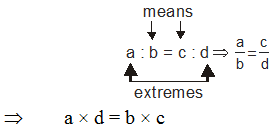
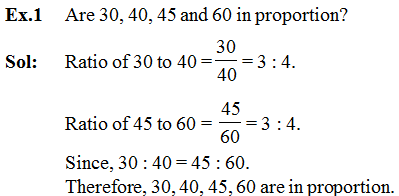
Ex.2 Do the ratios 15 cm to 2 m and 10 sec to 3 minutes form a proportion?
Sol. Ratio of 15 cm to 2 m = 15 : 2 × 100 (1 m = 100 cm) = 3 : 40
Ratio of 10 sec to 3 min = 10 : 3 × 60 (1 min = 60 sec) = 1 : 18
Since, 3 : 40 ∷ 1 : 18, therefore, the given ratios do not form a proportion.
Unitary method
- Books Name
- CBSE Class 6 Mathematics Book
- Publication
- Param Publication
- Course
- CBSE Class 6
- Subject
- Mathmatics
Unitary method
Let we see a problem.
If the cost of 3 pens is M12, what will be the cost of 8 pens ?
We have to find the cost of 8 pens, we know that it will be more than the cost of one pen. So we multiply M4 by 8 and we get M32. So the cost of 8 pens is M8 × 4 = M32
In the process of our calculation we found out the value of one unit (in this case cost of one pen)
So this method of solving is called unitary method.
The method in which first we find the value of one unit and then the value of required number of units is known as Unitary Method.
Ex.1 If the cost of 6 cans of juice is M210, then what will be the cost of 4 cans of juice?
Sol. Cost of 6 cans of juice = M210

Ex.2 A motorbike travels 220 km in 5 litres of petrol. How much distance will it cover in 1.5 litres of petrol?
Sol. In 5 litres of petrol, motorbike can travel 220 km.

Ex.3 If the cost of a dozen soaps is M153.60, what will be the cost of 15 such soaps?
Sol. We know that 1 dozen = 12
Since, cost of 12 soaps = M153.60


 Param Publication
Param Publication
 ReginaTagebücher
ReginaTagebücher
